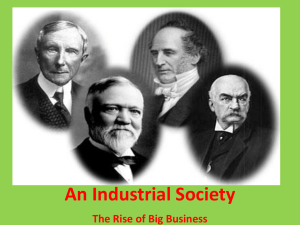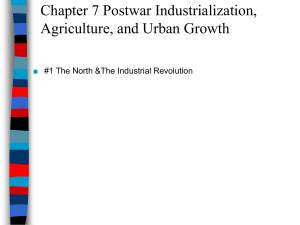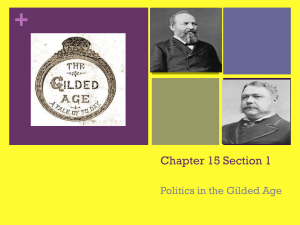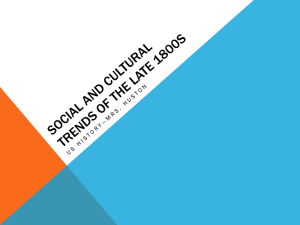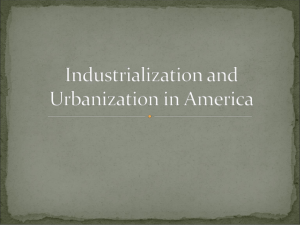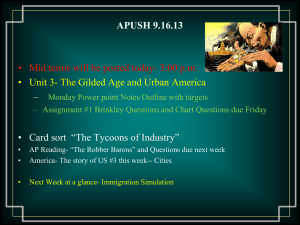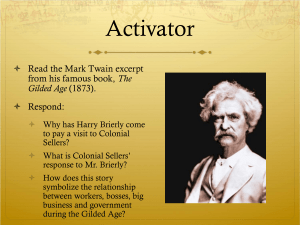PPT
advertisement
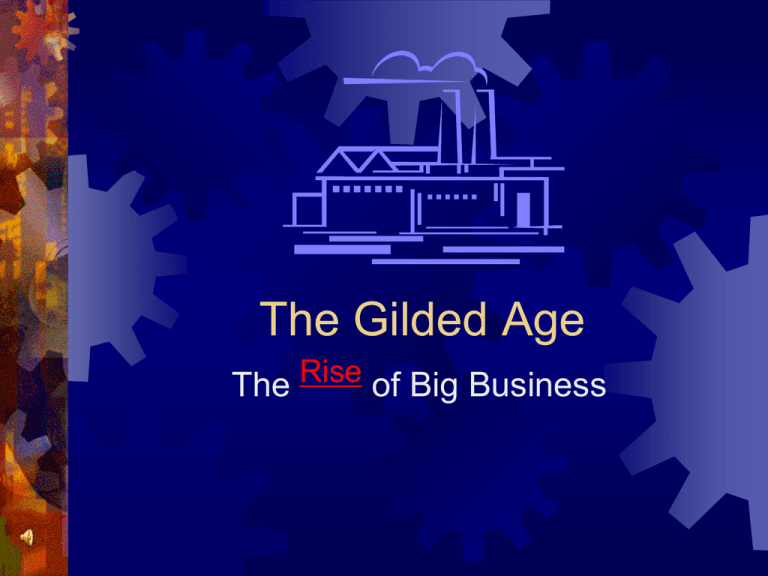
The Gilded Age
The Rise of Big Business
Essential Question:
• Was the rise of industry good for the
United States?
A Brassy, Flamboyant Age
Gilded Age:
{Reconstruction (1877) - Progressive Era
(1901)}
brassy, flamboyant age
dominated by big
business values, political
corruption, and
extremes of wealth and
poverty
Major Developments
Major Developments:
1. Industrialization
2. Urbanization
3. Immigration
From Agriculture to Industry
• During
Gilded Age,
U.S.
experienced
rapid shift
from an
agricultural
economy to
an industrial
one
Relative Share of World
Manufacturing
USA in the Gilded Age: 1870-1900
The North:
Experienced an industrial revolution,
mass immigration, & urbanization
Essential Question
Was the rise of industry good
for the United States?
Gilded Age Industrialization
• During the Gilded Age (1870-1900),
the United States experienced an
Industrial Revolution:
• New technology, transportation,
efficient mass-production spread
ideas & industrial products
• By 1900, the U.S. was the U.S. the
most industrialized country in the
world
An Age of Invention
• The Gilded Age was an Age of Invention
U.S. Patents Issued (1850-1899)
An Age of Invention
• The Gilded Age was an Age of Invention
•
What
is it?machines,
Cash registers,
adding
business typewriters
•
Alexander Graham Bell invented the first
telephone
•
The Bessemer process transformed iron
into stronger, lighter steel
An Age of Invention
• The Gilded Age was an Age of Invention
• Thomas Edison (Wizard of Menlo Park) was the
is it?
greatest inventorWhat
of the 1800s
• In his research lab in
New York, he created
the 1st audio recorder,
phonograph, and batteries
• His most influential
invention was the
1st electric light bulb
The Business of Invention
• New innovations allowed for increased
industrial production
• New machines were incorporated
into the 1st assembly lines that
allowed for faster mass production
• Railroads linked all regions
• America’s wealth of iron, oil, coal,
immigrant labor, & investment
capital (money) supplied factories
The Industrial Revolution was
fueled by 4 industries (R.O.S.E.)
Railroads, Oil, Steel, Electricity
Industrial
Resources:
Iron, Coal,
Railroads, &
Steel Plants
The Railroad Industry
• America’s first “big business” was
the railroad industry:
• Railroads stimulated the coal,
petroleum, iron, steel industries
Eastern RRs
were connected
to the West by 4
great trunk lines
Railroad growth fueled
industrial development
•
•
•
•
100,000 miles of track laid
between 1877 - 1893
standardization of gauge
• width of tracks (4 feet, 8 1/2
inches)
[encouraged development]
time zone adoption allowed
• U.S. divided into four zones
massive grants of American land
• 131 million acres -- federal
• 49 million acres -- states
Railroad Construction in the Gilded Age
Oil provided
kerosene
lighting &
lubrication for
industrial
machinery
Steel Production
Steel Production
• Steel transformed
world industry:
• Allowed for taller
buildings, longer
bridges, stronger
railroad lines, &
heavier machinery
Wadsworth Building, NYC
International
Steel
Production,
1880-1914
Efficiency & Mass Production in
Factories
Causes of Rapid
Industrialization
1. The Railroad fueled the growing US
economy:
* First big business in the US.
* A magnet for financial investment.
* Aided the development of other
industries.
Causes of Rapid
Industrialization
2. Technological innovations:
* Bessemer and open hearth
process
* Refrigerated cars
* Edison “Wizard of Menlo Park”
light bulb, phonograph,
motion pictures.
Causes of Rapid
Industrialization
3. Unskilled & semi-skilled labor in abundance.
•
U.S. population 3x from 1860 - 1910
4. Government aid at all levels to stimulate
economic growth
•
High tariffs {hurt exporters (farmers)}
5. Abundant natural resources
•
H2O, timber, coal, iron, copper, and oil
New Business Culture
Laissez Faire
an ideology of the
Industrial Age
Individuals should compete freely
in the marketplace.
No room for government in the market!
French -- "let it be"
New Business Culture
Entrepreneurs
(another) ideology of
the Industrial Age
People who risk their
$$$ in organizing and
running a business
French -- "to
undertake"
New Forms of Business
Organization
Corporation:
an organization owned
by many people,
treated (by law) as a
single person
People who own the
corporation are called
shareholders
Share of ownership is a
stock
Limited liability
New Forms of Business
Organization
• During the Gilded Age, business &
industry were transformed:
• Massive corporations replaced small, family
businesses
• Managers were hired to make factories run
more efficiently
• New business models, such as “trusts”
integrated various businesses under 1 board
of directors
New Business Organization
Combinations of
Corporations
(WHY?)
increases
efficiency and
profits
destroyed healthy
competition that
often makes
capitalism a viable
economic model
New Business Organization:
Board of Trustees (Trust)
Board of
Trustees
Company
Manager
Employees
Employees
Employees
Employees
“Trusts” use a board of trustees
to manage a company
New Forms of Business
Organization
• Corporations in the Gilded Age used
mergers to increase profits
• Companies used horizontal
integration to buy similar
companies to reduce competition
• Vertical integration allowed
companies to buy companies that
supply raw materials or
transportation for their products
Vertical & Horizontal Integration
Monopolies
• Corporate mergers
led to giant
companies called
monopolies:
• Companies that
control nearly all of
a particular industry
• Because most
monopolies of the Gilded Age were run by boards of
trustees, monopolies became known as “trusts”
• Monopolies led to a new generation of U.S. millionaires
U.S. Corporate Mergers
By 1900, 1% of U.S.
companies controlled
33% of all industry
The Monopolists
• Andrew Carnegie created
the Carnegie Steel
His company made more
Company:
steel
all thetofactories
• Hethan
converted
the
ofBessemer
Great Britain,
France
process
and
Germany
& was
able tocombined
out-produce his
competition & offer
better quality steel at lower prices
• He mastered vertical integration to lower his
production costs
U. S. Steel Corporation
• When he retired in 1901,
he sold Carnegie Steel to
financier J. P. Morgan for
over $400 million dollars.
Morgan subsequently
reorganized the company
into the United States
Steel Corporation.
USS
Andrew
Carnegie’s
Carnegie
did not pay his
employees
very much &
rise
from a poor
did not allow unions in
Scottish
his factories…
immigrant
to
one
the
richest
…butofhe
was
a philanthropist
men
in gave
the world
who
money to New
was
great
Yorkthe
City
libraries, colleges,
& performing
arts
example
of the
institutions
“American
Dream”
The Monopolists
• John Rockefeller created
the Standard Oil Company
• Used horizontal
integration to create a
petroleum company that
monopolized the oil industry,
lowered costs & improved
quality
• By 1879, Standard Oil sold 90% of all U.S. oil
& sold to Asia, Africa, & South America
Rockefeller was
labeled a “robber
baron” who took
advantage of
immigrant
workers,
driving
…but Rockefeller gave away
$500 million to charities, his competition
created the Rockefeller out of business, &
Foundation, & founded the used his fortune to
University of Chicago
influence the
national gov’t…
Captains of Industry
• Entrepreneurs were
able to achieve
unprecedented
wealth and power.
The
“Robber
Barons”
the Past
“Robber
Barons”
of theof
Gilded
Age
Giant Corporations
• By 1900, 2/3 of all
manufactured goods
were being produced by
giant corporations
• Swift and Armour
dominated meat
packing
• Duke family
controlled tobacco
• Andrew Carnegie
took over every
aspect of steel
production.
Swift
armour
1889 Duke Tobacco Advertisement
Distant Corporations
• Needs once met by
self-sufficient rural
folk now met by large
corporations usually
located in the
Northeast
Conclusions
• Due to the Industrial Revolution:
• The United States led the world in
industry, innovation, & wealth
• Laissez-faire gov’t policies & new
business tactics led to monopolies
• However, the gap between the wealthy
monopolists & their poor immigrant
workers grew wider
